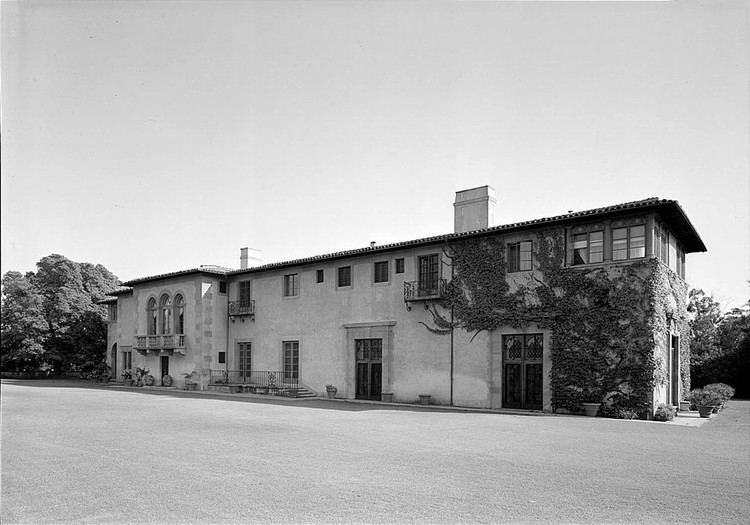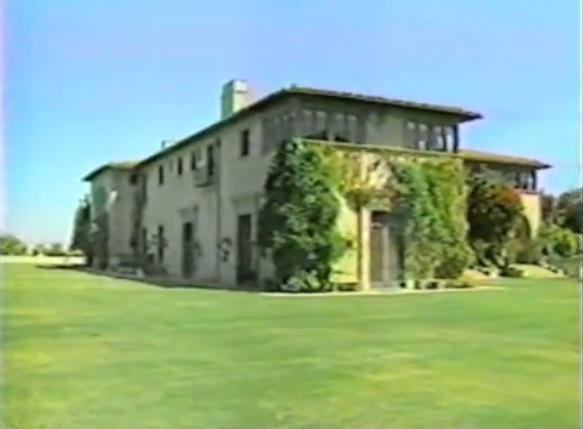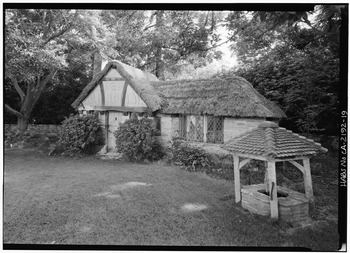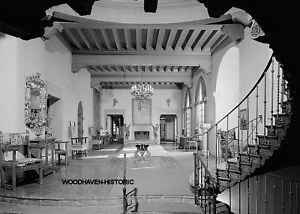Built 1928 NRHP Reference # 84000876 LAHCM # 279 Area 3 ha | Landscape architect A.E. Hanson CHISL # 961 Opened 1928 Added to NRHP 9 February 1984 | |
 | ||
Similar Pickfair, Virginia Robinson Gardens, Hollywood Melrose Hotel, Electric Fountain, Greystone Mansion | ||
The Harold Lloyd Estate, also known as Greenacres, is a large mansion and landscaped estate located in the Benedict Canyon section of Beverly Hills, California. Built in the late 1920s by silent film star Harold Lloyd, it remained Lloyd's home until his death in 1971. The estate originally consisted of a 44-room mansion, golf course, outbuildings, and 900-foot (270 m) canoe run on 15 acres (61,000 m2). Greenacres has been called "the most impressive movie star's estate ever created." After Lloyd died, the acreage in the lower part of the estate along Benedict canyon was subdivided into approximately 14 large home lots, though the mansion remained up on top of its own hilltop with approximately 5 original acres of flat land and was added to the National Register of Historic Places in 1984.
Contents
Planning and construction

In 1923, Lloyd purchased a historic home site from P.E. Benedict at the mouth of Benedict Canyon in Beverly Hills, California. The land had been owned by the Benedict family for more than sixty years and was close to the spot where Mary Pickford and Douglas Fairbanks had built their famed Pickfair estate.
In 1925, Lloyd hired architect Sumner Spaulding of the firm Webber, Staunton & Spaulding, after an introduction by landscape architect A.E. Hanson, to design a house on the property. Lloyd also hired Hanson to landscape the 15-acre (61,000 m2) grounds.

The final plans for the house were not completed until July 1927, at which time the Los Angeles Times published the architectural drawing. The home was designed in the Italian Renaissance Mediterranean Revival style: modeled after the Villa Palmieri near Florence. Construction of the mansion began in July 1927 and was completed in 1928.
The 44-room, 45,000-square-foot (4,200 m2) house and estate was said to have cost $2 million.
Features

A.E. Hanson, Lloyd's landscape architect, transformed the 15-acre (61,000 m2) site with the Villa Lante and Villa Medici as inspiration in Mediterranean Revival and Spanish Revival style motifs. The Los Angeles Times published a full-page illustrated article describing it as a "gorgeous fairyland playground" and a "Modern Eden of groves and gardens." The elaborated design of the grounds' landscape and gardens included the following elements:

The landscaping project was so large that 3,500 tons of sandstone were taken from quarries in Chatsworth and trucked to the site for use in building the steps, terraces, and waterfalls.
An unusual feature was the separate fairyland estate that Lloyd and A.E. Hanson designed for Lloyd's four-year-old daughter, Mildred Gloria. The play village had its own private gate with a sign reading, "Come into my garden and play." The fairyland estate included a four-room miniature old English house, a miniature old English stable with a pony and cart, Great Dane dogs, a wishing well with water for the daughter's garden, a slide, acrobatic devices and a swing. The miniature house had electricity and a kitchen and bath with running water, where the Lloyds' daughter played with friends, including Shirley Temple.
Family home
Lloyd named his estate "Greenacres," and it became a gathering place for the Lloyds' family and friends. Sundays were known as "at home" day at Greenacres:
"The 'at home' day at Greenacres was Sunday when 30 or 40 friends would gather in the afternoon, amuse themselves with golf, tennis or handball, swimming, or with leisurely strolls through the gardens. A buffet would be set in the formal dining room and in the evening Lloyd would show a movie. Then he would wave everyone goodnight."
In 1937, Mrs. Lloyd hosted a bridal shower at the estate for Jeanette MacDonald attended by Hollywood's elite, including Ginger Rogers, Mary Pickford, Irene Dunne, Fay Wray, Norma Shearer, Dolores del Río, Loretta Young, Mervyn LeRoy, Ernst Lubitsch, Hal Roach and Darryl Zanuck.
As the Harold Lloyd Estate had been built within Beverly Hills in the 1920s, its location was within one of Los Angeles' all-white planned communities. The area had restrictive covenants prohibiting non-whites (this also included Jews.) from owning or renting property unless they were in the employment of a white resident. In 1940, Lloyd supported a neighborhood improvement association in Beverly Hills that attempted to enforce the all-white covenant in court after a number of black actors and businessmen had begun buying properties in the area. However, in his decision, federal judge Thurmond Clarke dismissed the action stating that it was time that "members of the Negro race are accorded, without reservations or evasions, the full rights guaranteed to them under the 14th amendment." In 1948 the United States Supreme Court declared in Shelley v. Kraemer that all restrictive covenants were unenforceable.
With the demise of his movie career, the size of the estate began to cause financial difficulties for Lloyd. In 1943 he petitioned the Los Angeles County Board of Supervisors to reduce his property taxes because, although he and his family wanted to continue living there, he said the taxes were "eating them out of house and home." The Board refused to reduce the $58,730 assessed valuation of the 15 acres (61,000 m2) estate but it did limit the $119,840 valuation of the improvements to $100,000 per annum. Lloyd was forced to reduce the estate's staff and parts of the estate began to deteriorate out of neglect.
In 1943, one of his two film vaults on estate - containing original negatives and prints - caught fire. According to his granddaughter Suzanne, Lloyd valiantly rescued as much material as he could before the vault was engulfed in flames.
In his later years, Lloyd lived a private life on his estate. He would start each day with a jog around the grounds followed by a swim in the pool. He also developed an "addiction to stereo that shook the mansion at 3am with the force of 10 speakers in unison"; the decibel levels caused the gold leaf to fall from the ornate living room ceiling.
Lloyd lived at the estate until he died of cancer in 1971, aged 77. A long-time member of staff noted that he had a superstition wherein he would never be driven around the Italian fountain in the estate's front court, always making his chauffeur back up rather than circle the fountain. However, "the only time he ever went around that fountain was the night he died."
Preservation attempts
Lloyd left his Benedict Canyon estate to the "benefit of the public at large" with instructions that it be used "as an educational facility and museum for research into the history of the motion picture in the United States." For a few years the home was open to public tours, but financial and legal obstacles prevented the estate from creating the motion picture museum that Lloyd had intended. Among other things, neighboring homeowners in the wealthy community were opposed to the creation of a museum hosting parties and attracting busloads of tourists.
In October 1972, the Los Angeles Times visited the property and noted that it had "the feel of Sunset Boulevard," bringing to mind the line spoken by the young writer when he first visits Norma Desmond's home: "It was the kind of place that crazy movie people built in the crazy 20s." The house appeared to visitors in the 1970s to be frozen in time at 1929. One writer noted that nothing had been moved or replaced, changed, or modernized, from the books in the library to the appliances in the kitchen and the fixtures in the bathrooms. Noted columnist Jack Smith visited the estate in 1973 and wrote that "time stood still", as Lloyd's clothes still hung in his closet, and the master bedroom and living room "looked like a set for a movie of the 1930s." A Renaissance tapestry presented to Lloyd as a housewarming gift by Mary Pickford and Douglas Fairbanks was still hanging in the hallway.
The house also had Lloyd's permanent Christmas tree loaded with ornaments at the end of a long sitting room. Jack Smith described the tree as follows:
"[A]t the end of the room, dominating it like some great Athena in a Greek temple, stood the most fantastic Christmas tree I had ever seen. It reached the ceiling, a great, bulbous mass of colored glass baubles, some of them as big as pumpkins, clustered together like gaudy jewels in some monstrous piece of costume jewelry."
Sale and break-up
With the inability to establish the museum, the estate was sold at auction in 1975. The entire property, including grounds and furnishings, was purchased by a retired Iranian businessman, Nasrollah Afshani, for $1.6 million -- $400,000 less than Lloyd had spent to build the estate 50 years earlier. Afshani subdivided the estate into approximately 15 lots in addition to the mansion, with individual lots selling for as much as $1.2 million.
The mansion was preserved on a smaller 5-acre (20,000 m2) parcel and sold for $3 million in 1979 to Bernard C. Solomon, the president of Everest Record Group. In 1986, Ted Field, heir to the Marshall Field department store chain and head of Interscope Films, bought the property for $6.5 million and lived there with his wife and their three children. The Fields extensively updated and renovated the entire home and grounds and added a pool back to the site. (The original pool located down closer to Benedict Canyon had been lost in the 1975 subdividing of the property.) Restoring everything except the original theater-size forty-rank pipe organ (which remains today behind the walls of the 80-foot (24 m) living room), the Field family replaced all the electrical wiring and plumbing and modernized the kitchens and bathrooms before moving into the estate. An 80-year-old carousel with hand-carved horses was added to the children's play yard and the same security system used at the White House.
Field hosted a gala political fundraiser for Bill Clinton and Al Gore at the estate in 1992 where Barbra Streisand performed a concert in the formal garden for 1,200 of Hollywood's most influential, including Warren Beatty, and a relatively unknown heavy contributor Ron Burkle, who would end up buying the property the next year. In 1993, billionaire and Democratic Party fundraiser Ron Burkle bought the home for $20 million -- $19 million less than the $39 million asking price (which had included a valuable art collection of old masters paintings in the original asking price) but still among the highest prices paid for a home in the United States in the previous three years. On May 20, 1994, the estate hosted yet another gala fundraiser attended by President Bill Clinton at which R&B singer Natalie Cole performed.
In 2001, the mansion was estimated to be worth $50–60 million.
The main house and the estate's principal gardens are frequently used for civic fundraising events and as a filming location, appearing in films such as in Commando, and Westworld.
